Summary
Integration of microseismicity and reservoir properties has been used to design better well placement, improved stimulations and enhanced production of wells in the Montney shale in NE British Columbia, Canada. In a companion paper, observations were presented of how reservoir heterogeneity in terms of Poisson’s ratio and pre-existing faults impacted microseismically imaged hydraulic fracture geometry. This paper describes investigation of the variability in the geometry of hydraulic fractures by integrating seismic reservoir characterization information with source analysis of microseismicity recorded during the stimulation of three horizontal wells. Larger amounts of seismic deformation, anomalous frequency-magnitude relations and focal mechanisms were found when the hydraulic fractures interacted with the preexisting faults. The faults appear to limit the extents of the hydraulic fracture growth, and also result in lower gas production. The hydraulic fractures were also found to preferentially grow towards regions with low Poisson’s ratio, which will tend to be associated with lower shut-in injection pressures attributed to low stresses. Understanding the impact of reservoir heterogeneity and structures on the hydraulic fractures is critical to optimizing the production from these wells.
Introduction
Microseismic imaging of hydraulic fractures is a common diagnostic technology in all North American tight gas and shale gas fields. Fracture stimulation for enhanced permeability is a critical step for economic exploitation of these unconventional reservoirs. Microseismic imaging has shown that hydraulic fractures are much more complex than originally thought, with fractures often showing a high degree of depth containment and long fracture lengths. Another significant learning is that the hydraulic fractures often interact with pre-existing fractures in the reservoir. Typically, hydraulic fractures are considered to be single tensile fractures created orthogonal to the direction of minimum principal stress. However, the injected fluid will follow a path of least resistance and depending on the stress conditions, may intersect pre-existing planes of weakness associated with either healed or open fractures. The resulting hydraulic fracture is therefore more complex than a single hydraulic fracture plane, consisting of an entire fracture network.
Microseismic hydraulic fracture images have also shown that there can be significant variability of fracturing over relatively short distances. For example, hydraulic fractures have been found to change from simple fracture planes to complex fracture networks, fracture directions change, and the fracture dimensions of height and length can also dramatically change even over the length of a single horizontal well (e.g. Rich and Ammerman, 2010). Furthermore, fracture asymmetry (i.e. preferentially growing in a certain direction) has been observed to rapidly change over short distances. These observations suggest that reservoir heterogeneity, in terms of rock fabric, stress and pore pressures are important factors contributing to this variability. The variability also points to the value of integrating reservoir characterization and microseismic monitoring: where the results can be used to better design the hydraulic fracture stimulations and better understand the reservoir drainage for subsequent well placement.
In order to better understand the influence of reservoir heterogeneity, efforts are growing to compare microseismicity with seismic reservoir characterization as well as well logs (e.g. formation imager or advanced sonic logs). In a companion paper (Norton et al., 2011), integration of Poisson’s ratio, ant tracking and microseismic was shown to help explain the variability of hydraulic fractures in the Montney shale. In this paper, we further discuss the case study and investigate microseismic source characterization and interpretation of injection pressures to investigation the geomechanical conditions controlling the hydraulic fracture variability.
Case Study
We investigate the stimulation of three horizontal wells in the Montney formation in NE BC. While generally considered to be a shale, the Montney is best described as a silty sandstone (further details are contained in the companion paper). Low matrix permeability in the range of microdarcies, requires hydraulic stimulation for economic gas production. Multiple stage stimulations were performed along the length of each horizontal well, with the associated microseismicity recorded for each of these stimulations. AVO inversion of surface seismic reflection data was performed to estimate the Poisson’s ratio through the reservoir, and an edge detection algorithm (ant tracking) was also applied to the reflection data to assess pre-existing faults (see companion paper for further details). Figure 1 shows a superposition of the microseismic, Poisson’s ratio and edge detection data, indicating that the microseismic activity appears to concentrate in regions of low Poisson’s ratio (hot colours). There is also a prevalence of pre-existing faults sub-parallel to the well trajectories.

Clearly there is evidence of reservoir heterogeneity which is controlling the hydraulic fracture geometry. In this paper we will further examine these observations and attempt to answer the following questions:
Why are the microseismic events large along Well C?
Why are there no microseismic events towards the NE?
Why do the microseismic events tend to go towards the SW?
Why is the geometry of the microseismic events different near Well A?
To dig deeper into the microseismic response, seismic moment density (measure of microseismic strength or deformation) and b-values (slopes of frequency-magnitude distributions) were computed. Seismic deformation and b-values are useful microseismic attributes to discern if hydraulic fractures result in fault activation (Maxwell et al., 2010). Hydraulic fractures intersecting pre-existing faults generally results in increased microseismic magnitudes as well as lower b-values. For each well, the stages closest to the monitoring well were examined, where the location accuracy and signal-to-noise ratio was highest. In this case, seismic moment density (Figure 2) shows a region of relatively high microseismic deformation following a trend approximately parallel to the NW-SE trajectory of the southern most well C. b-values (Figure 3) are approximately 1 in this region of high deformation, suggesting a fault activation mechanism. In contrast, the microseismicity associated with well A define a clear NE-SW trend and have a higher b-value. The moment density is also smaller for these events. These results for well A are more typical of a simple planar hydraulic fracture parallel to the expected maximum stress direction. Composite fault plane solutions for these two clusters of events also showed that the events associated with the high moment density and low b-value near Wells B and C are consistent with a shear slip striking in the NW-SE direction (Maxwell et al., 2011). The hydraulic fracture related events near well A following the NE-SW trend are consistent with a shear strike-slip in that direction.
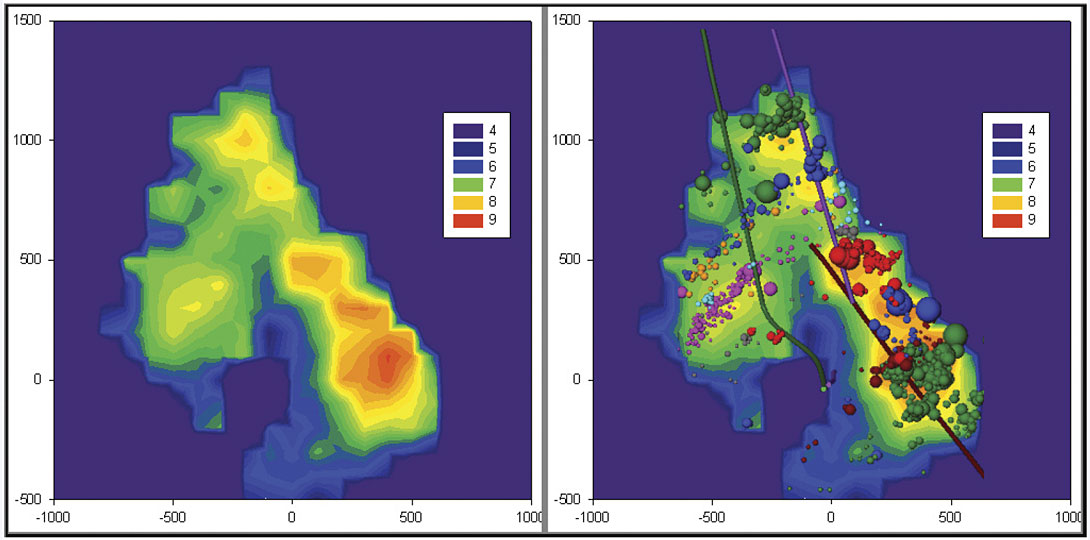
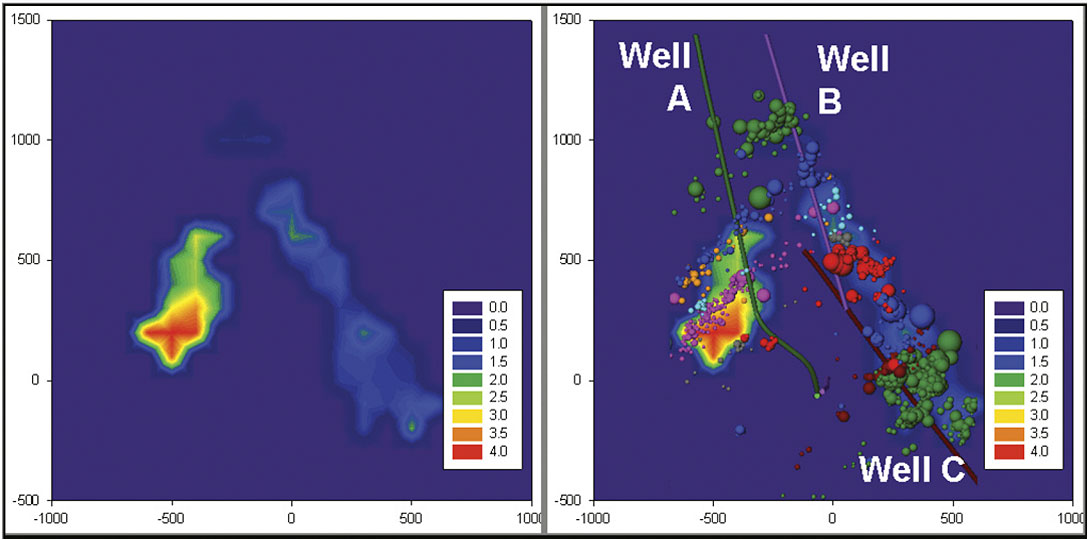
Injection data during the hydraulic fracture stimulations were also investigated. At the end of the injection, the instantaneous shut-in pressure (ISIP) was examined which is a measure of the minimum principle stress. Figure 4 shows the relative ISIPs for each stage overlain with the Poisson’s ratio. Generally, low ISIPs are found in the low Poisson’s ratio regions, suggesting that these regions represent regions of lower stress.
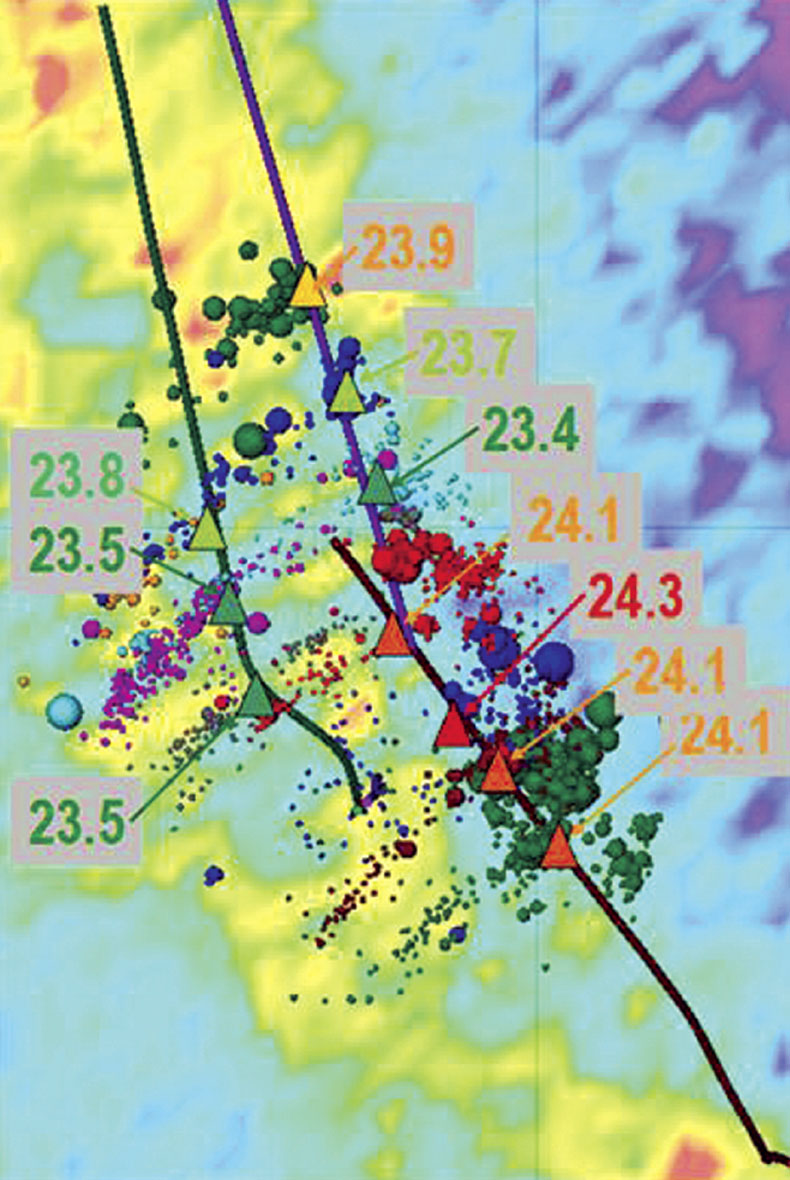
The case study also shows an interesting aspect in terms of well interference. Figure 5 shows the microseismic from the two wells, where the microseismic locations are seen to overlap. The hydraulic fractures in each well stimulated the same fracture network, and resulted in interfering hydraulic fracture networks between the wells. Production data was also examined for the three wells (Figure 6). Production rates from Wells A and C are significantly better than Well B. Also notice that the production on Well A falls as Well B comes on line, indicating interference as the two wells attempt to drain the same portion of the reservoir. Understanding the hydraulic fracture networks created in each well, allows better well placement to avoid well interference.

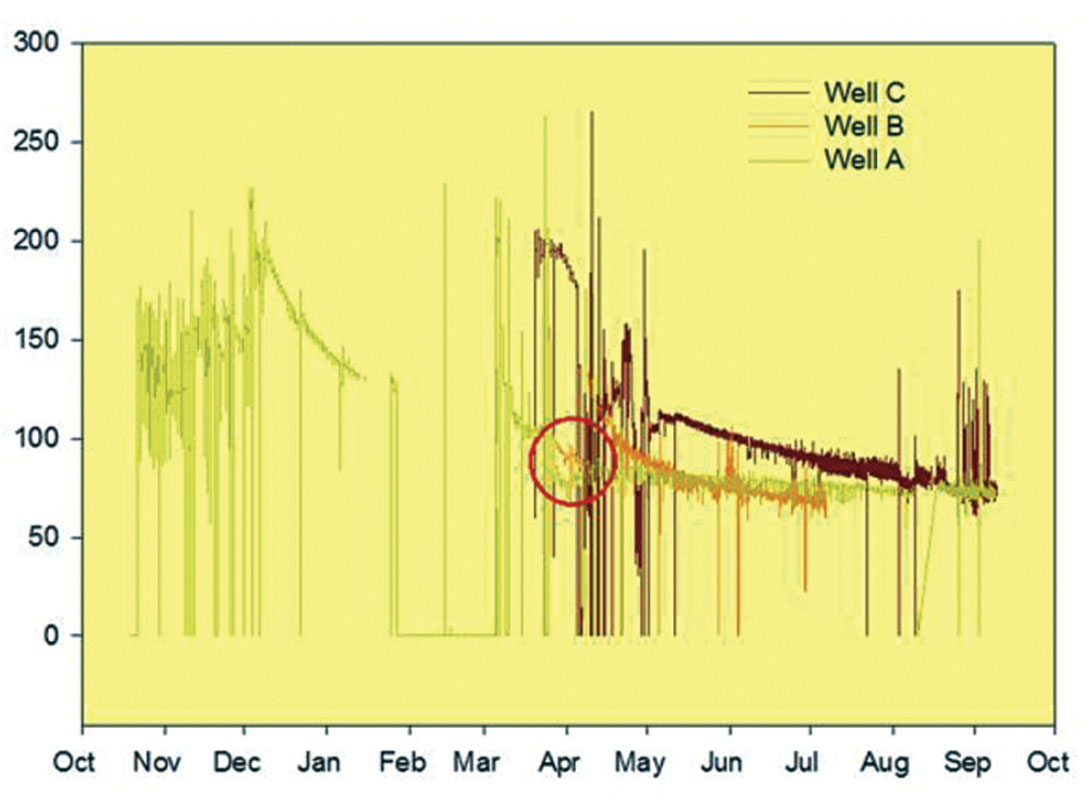
Discussion
Returning to the questions about the hydraulic fracture geometry, each are discussed in turn.
1. Why are the microseismic events large along Well C?
The seismic deformation, b-values and focal mechanisms all point towards interaction of the hydraulic fractures with a NWSE striking fault system. While the fault interaction is predominantly associated with fracturing Wells B and C, a small indication is found for the NE extent of the Well A microseismicity. Ant tracking indicates a fault associated with a lateral discontinuity in reflections below the reservoir, directly under the region of largest seismic deformation (Figure 7). The large number of high magnitude microseismic events along Well C is attributed to fault activation consistent with the vertical extension of this fault.
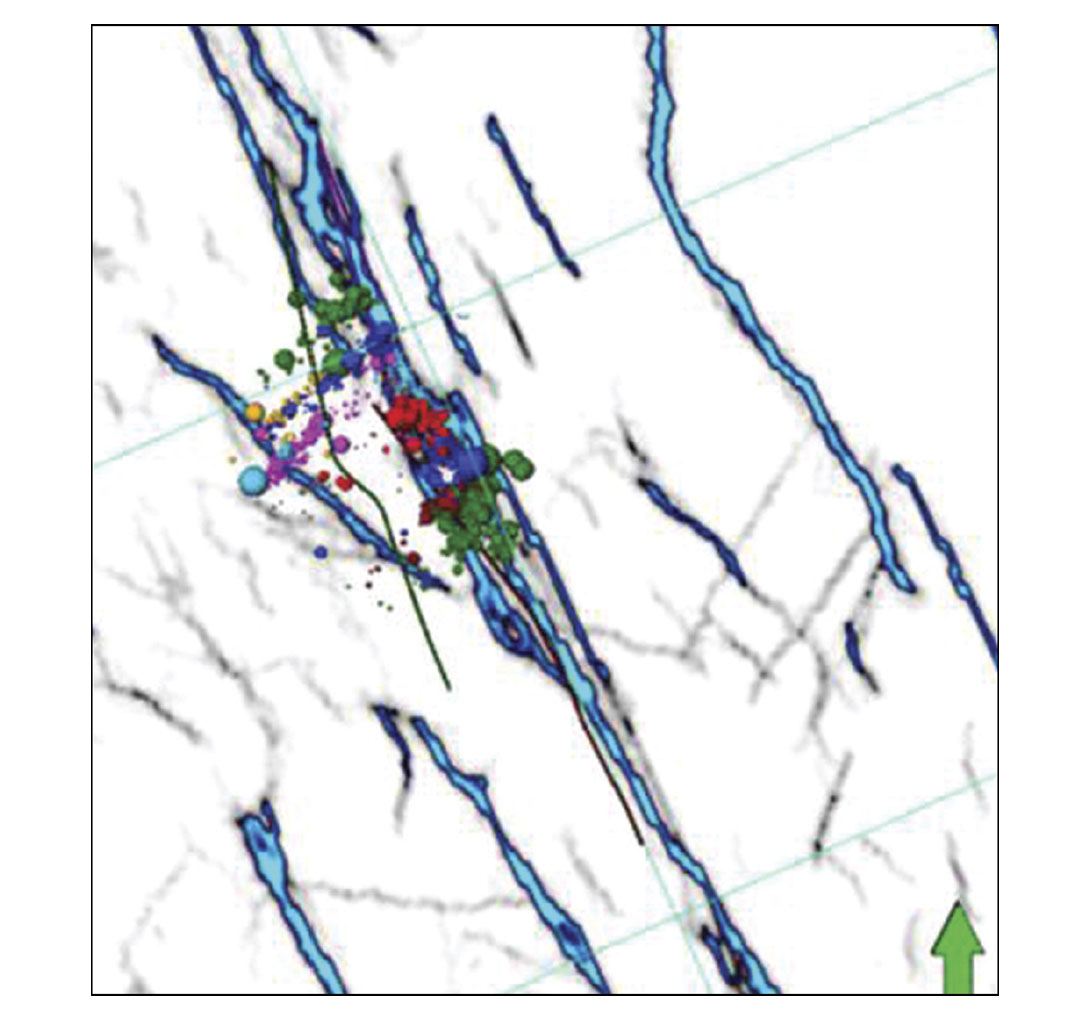
2. Why are there no microseismic events towards the NE?
If microseismicity had occurred further to the NE, it would have been detected by the microseismic array. The interaction between the hydraulic fracture and fault system appears to act as a barrier to the hydraulic fracture extending further to the NE. As long as the permeable open fault allows fluid penetration within the fault network, it is easy to imagine that it would be unlikely to create a new hydraulic fracture. Well C, however, does have an indication of microseismicity to the SW of the well (occurring later in each stage) which suggests that eventually the hydraulic fracture does start to grow out of the fault network. As described in the next section, the microseismicity then moves in a SW direction similar to the rest of the wells. Therefore, the lack of microseismic event towards the NE is attributed to fracture asymmetry associated with the fault system near Wells B and C.
3. Why do the microseismic events tend to go towards the SW?
The microseismicity from each well grows preferentially in a SW direction, towards the direction of lower Poisson’s ratio. A constrained, horizontal stress effect is associated with transverse strain resulting from the vertical lithostatic load which is given by:
σH = σh = (ν/(1 - ν)) * σzz + σtectonic
and would result in lower stresses in lower Poisson’s ratio (n) material and result in more hydraulic fracture growth in that direction. The observed ISIP gradients (Figure 5) are also consistent with lower stresses in the lower PR regions.
4. Why is the geometry of the microseismic events different near Well A?
The microseismic events associated with stimulation of Well A are distributed in the maximum stress direction, as expected for a tensile hydraulic fracture. Therefore, Well A appears to be anomalous simply due to the lack of fault activation seen around Wells B and C.
Conclusion
The distribution of the microseismicity recorded during the hydraulic fracturing of these wells appears to be controlled by both the reservoir heterogeneity of the reservoir and pre-existing fault networks. During the frac of the first well A, the microseismicity shows a conventional hydraulic fracture, trending in the expected NE-SW direction: orthogonal to the minimum stress direction. This well is in the center of the low Poisson ratio region and does not interact with pre-existing faults, ultimately resulting in the best production out of the three wells. While the distribution is approximately symmetric, there are a larger number of events and more deformation to the SW in the direction of the lower Poisson’s ratio (Figure 2). The second well B, is drilled along the inferred NW-SE fault system and results in significantly more deformation concentrated near the well. Microseismicity associated with well B also grows asymmetrically towards the SW overlapping with the well A microseismicity, indicating interaction between the hydraulic fracture networks. Production data from these wells confirms well interference between these two wells. The third well C, also is drilled along the NW-SE fault system and the hydraulic fracture again results in significant seismic deformation along the well. Less seismic deformation occurs as the microseismicity moves SW towards the low-Poisson’s ratio region. The NW-SE trending fault structure appears to act as a barrier to the fractures growing further to the NE. The pre-existing fault structures have the strongest control on the hydraulic fracture and microseismic distributions, although the fractures do seem to preferentially grow towards the lower stress areas with low Poisson’s ratio. Clearly understanding these controls is critical to enable a properly designed and executed well stimulation design as well as better plan future well placements.





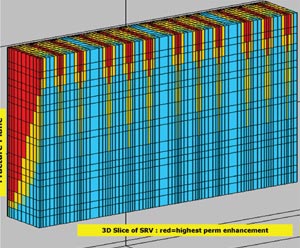
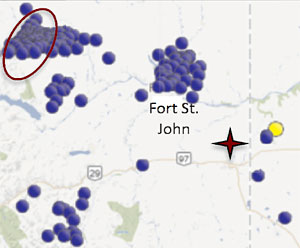
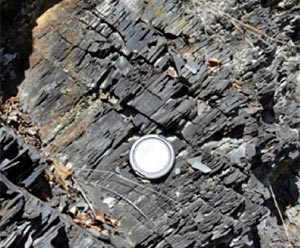







Join the Conversation
Interested in starting, or contributing to a conversation about an article or issue of the RECORDER? Join our CSEG LinkedIn Group.
Share This Article